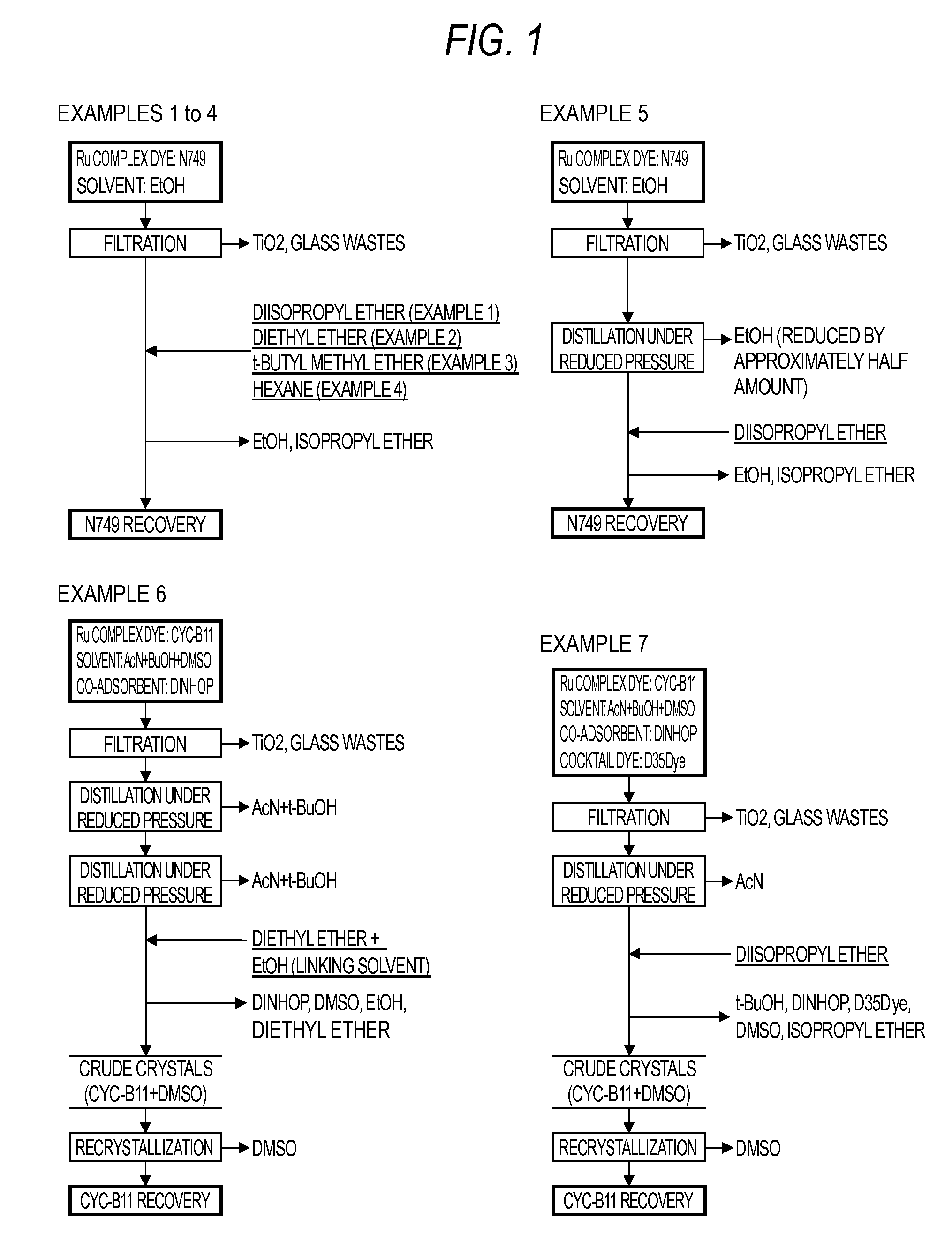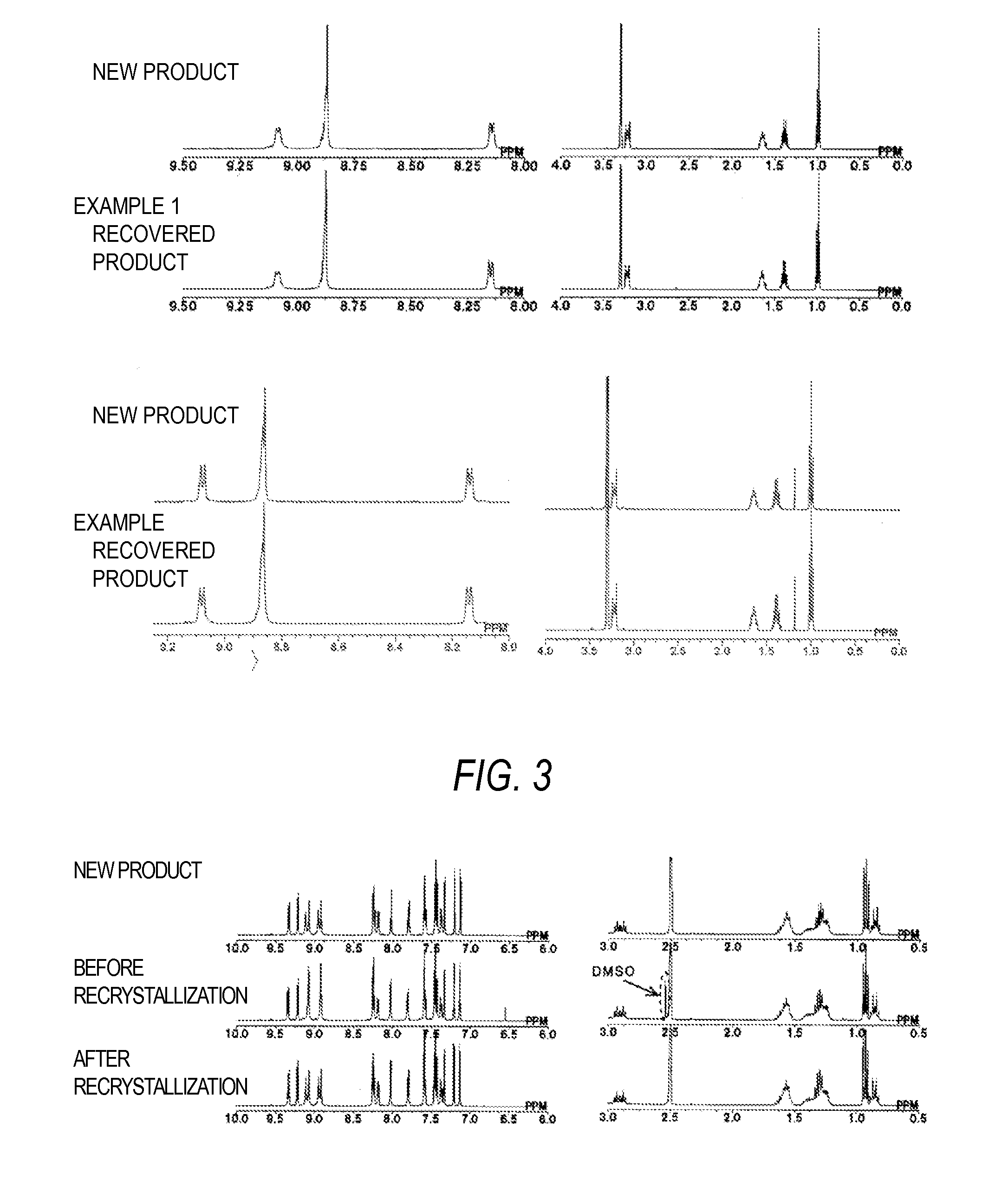METHOD FOR RECOVERING Ru COMPLEX DYE FROM USED DYE SOLUTION
- Summary
- Abstract
- Description
- Claims
- Application Information
AI Technical Summary
Benefits of technology
Problems solved by technology
Method used
Image
Examples
example 1
[0049]As a dye solution with the simplest constitution, a treatment of a used dye solution consisting of a Ru complex dye and a solvent was performed. The used dye solution as a subject for the treatment is 250 mL and the constitution is as follows.
[0050]Ru complex dye: N749 (0.3 mM)
[0052]For the aforementioned used dye solution, a treatment of the filtering step was performed first. For the filtering step, a membrane filter having 0.1 μm pores was used and the filtering under reduced pressure was performed after lowering the pressure to 0.04 MPa. Accordingly, the solid content was removed. The solid content was fine powder consisting of TiO2 and glass.
[0053]Next, the treatment of the separating step was performed. As a separating solvent, 1000 mL of diisopropyl ether was added to the dye solution. According to the addition of a separating solvent, precipitation of the Ru complex dye was shown. The Ru complex dye was separated by filtration followed by washing ...
examples 2 to 4
[0054]Here, recovery of Ru complex dye (N749) which has been applied with various separating solvents was performed for the same used dye solution as Example 1. The recovery step and conditions like use amount of a separating solvent, or the like are the same as Example 1.
[0055]For the Ru complex dye recovered from Example 1 to Example 4, 1H-NMR analysis was performed. Results of the Ru complex dye recovered from Example 1 and Example 3 are shown in FIG. 2. As it is recognized from FIG. 2, the Ru complex dye recovered from Example 1 and Example 3 exhibits the same spectrum as a new product N749, and from these examples, it was confirmed that highly pure Ru complex dye (N749) can be recovered. Meanwhile, recovery of highly pure Ru complex dye was also confirmed from Examples 2 and 4.
example 5
[0056]Here, a distillation step was added for the same used dye solution as Example 1 to recover Ru complex dye (N749).
[0057]The filtering step is the same as the one in Example 1. In addition, for the distillation step, distillation under reduced pressure was performed with conditions including a pressure of 1000 Pa and a temperature of 40° C. The distillation was performed in a dark space by using an inert gas (argon) circulating type distillation device. With this distillation step, almost half of the ethanol as a solvent was removed.
[0058]After the distillation step, 400 mL of diisopropyl ether was added as a separating solvent to the dye solution. Accordingly, precipitation of Ru complex dye was shown. After separating the Ru complex dye by filtration, it was washed with diethyl ether. The recovered Ru complex dye was subjected to 1H-NMR analysis, and as a result, it was confirmed that highly pure Ru complex dye (N749) which exhibits the same spectrum as a new product (immediat...
PUM
 Login to View More
Login to View More Abstract
Description
Claims
Application Information
 Login to View More
Login to View More - R&D
- Intellectual Property
- Life Sciences
- Materials
- Tech Scout
- Unparalleled Data Quality
- Higher Quality Content
- 60% Fewer Hallucinations
Browse by: Latest US Patents, China's latest patents, Technical Efficacy Thesaurus, Application Domain, Technology Topic, Popular Technical Reports.
© 2025 PatSnap. All rights reserved.Legal|Privacy policy|Modern Slavery Act Transparency Statement|Sitemap|About US| Contact US: help@patsnap.com



